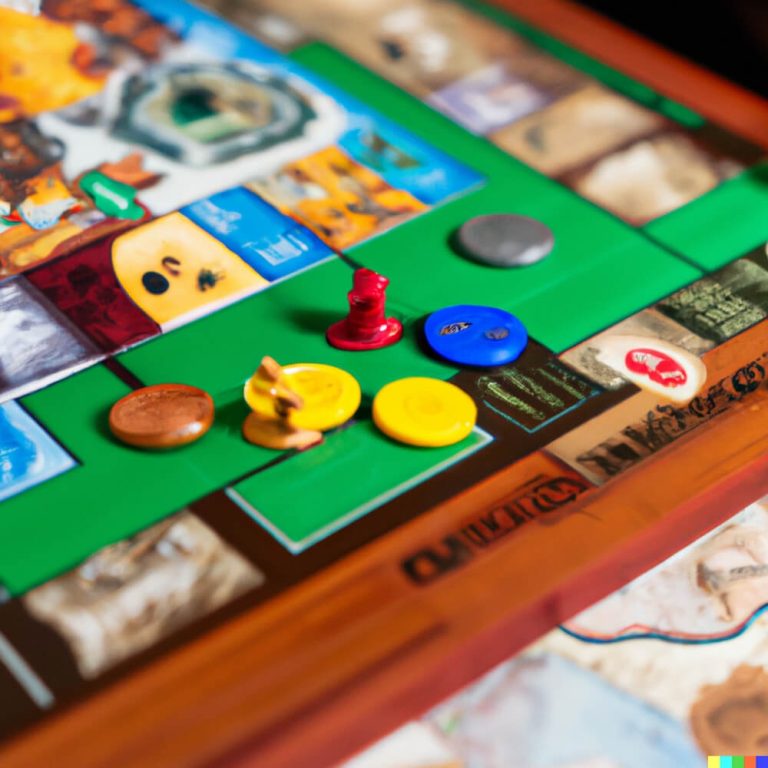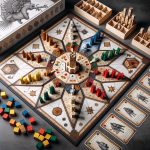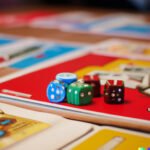Introduction
Board game components make all the difference when playing a game. Quality components are essential for creating customer satisfaction, as players spend more enjoyable time playing with components that look and feel high quality. In addition, some board games require specific materials such as wooden pieces or cardboard cutouts. High-quality components can also showcase unique artwork which is one of the most essential elements for designing games. Here are some tips on how to make quality components for your board game.
1. Choose Durable Materials: The key to high-quality game componentry is making sure they are made from materials that are durable and long-lasting. Opting for higher grade materials like plastic or metal will ensure your game pieces stand up to repeated use over time.
2. Get Creative With Your Designs: Adding a personal touch to your component designs will make them stand out from the competition and bring an added level of satisfaction to players who enjoy seeing unique artwork adapted for different boardgames.
3. Ensure Quality Printing And Craftsmanship: Quality printing of artwork and labels onto game pieces is an essential part of how customers interact with their gaming experience; it should be legible and true-to-life in color and texture, while ensuring no blemishes or defects exist on the printed material itself. On craftsmanship, using sharp edges and well formed pieces shows attention to detail, increases longevity, and adds value to the overall look and feel of a boardgame’s components.
4. Test Components Intensively Before Launch: Customers pick up on weaknesses quickly so it’s important that your prototypes are extensively tested by suitable personnel before launch; this ensures issues have been identified and rectified ” resulting in fewer complaints or refunds once launched buy customers who have invested money in your product!
Research
Research can be an important part of creating quality components for your board game. You should research available materials, designs, and other components that are necessary to create your board game. This includes looking into physical libraries (such as local and university libraries) and online resources (including patents, suppliers, manufacturers, etc.). Additionally, it’s important to consider the practicality of different options when choosing components. For example, some materials may look nice but are difficult to handle during game play and setup. Additionally, consider what type of look or aesthetic you want for the pieces in your game before buying components or deciding which design elements will go into the pieces. Finally, make sure to cost out any parts you plan on purchasing to ensure that the project remains within budget.
Design
When designing the components for your board game, it is important to consider the size, shape, and weight of each piece. This is especially important if you will be mass producing the game in larger quantities. Making sure your components are consistently sized and shaped not only makes production easier, but also ensures that your game looks professional.
When starting to design your pieces, it can be helpful to make fast initial sketches of what the pieces could look like. From here you should refine the sketches by creating accurate measurements and noting any details that would be necessary for production. It may also be beneficial to use digital tools such as freeware templates or vector art editing programs to make any detailed edits or scale objects with accuracy. After you have created a definitive design document which covers size, shape, materials etc., then it’s time to start finding a manufacturer or getting quotes from potential suppliers who will produce these items for you. By having an accurate 3D or 2D manual ready of your components in advance, this can shorten production time for those offering quotes and proposal manufacturing timelines can reflect more accurately on how long it will take.
Prototyping
Making quality components for your board game starts with prototyping. Before committing to a finished version of the game, testing its gameplay and functionality is essential to ensure high quality components. To achieve this, there are a few tools and methods to create a prototype.
One common tool is plastic or foam 3D prototypes that can be easily cut, bent and painted to resembance game pieces components such as cards, dice, counters and play money. In addition, 3D printer models allow intricate designs such as elaborately shaped characters or game pieces with more detail than normal printing can provide.
Another way to test out a game are using printable materials like paper and cardboards. Printable template components of cards, boards and even textured backgrounds have become increasingly easy to find online. Once printed at home or sent to an external printing company, these simulated versions allow the user to get a tangible sense of the product before investing in costly production models or materials like plastics or metals for a finalized version of the game components.
Ultimately whatever method one chooses depends on cost versus quality feedback from players and testers. Experienced players who share their views on gameplay help shape better decisions in designing truly unique games full of good-quality components ready for market success.
Material Choice
The materials you choose for your board game components can affect the overall quality of the game. Wooden components are often chosen for their sheer durability and ability to last through many uses. Wood boards and boxes are generally more resistant to wear and tear. Wooden pieces also offer a classic aesthetic that can enhance any game’s design. However, wood components tend to be heavier and may be more expensive than other materials. Cloth boards provide a different experience as they can be lighter and colorful. Though cloth boards may be less durable overall, they do provide a unique tactile experience for players making them great for some games. Ultimately, it’s important to consider all aspects of the game before deciding on a material, such as price, weight, durability, aesthetics and playing experience when creating quality components
Quality Control
1. Pre-Production: Start by examining images of the proposed components and ensure they meet all your design requirements. Pay close attention to colors, consistencies, shapes, sizes, and any surface details that should be included in the finished product.
2. Pre-Assembly: After the images have been approved visually, begin testing the actual components to assess their physical qualities. Measure the pieces against expected criteria and examine them closely for any damage or imperfections that could affect the final product.
3. Assembly: Carefully assemble each piece as per preapproved specifications to ensure tight connections with no parts left loose or incorrectly placed. Test durability by carefully simulating real game conditions and assess overall quality for potential issues such as chips in paint models or broken connectors/joints on larger items.
4. Post-Assembly Quality Control: Here you should again inspect each component to evaluate its performance when used together in a game. This should take into account things such as functionality of moving pieces, accuracy of all game elements, overall viability of gameplay, etc. Make sure to also put each finished unit through further safety testing protocols if required such as passing an inflammability test for plastic components or a durability test for wooden boards/pieces .
5. Final Check: Finally review your entire process one last time before sending it off to your manufacturer/production plant before mass production is done. Go through all pre-production and post-assembly inspection steps again to ensure every detail has been taken into consideration before mass production begins and leaving you with a quality board game that’s ready for sale!
Production
In order to efficiently produce components for your board game, streamlining the production process is key. To ensure that all components are of a high quality and remain cost effective while still maintaining a high standard, you should consider the following tips.
Materials: Before beginning production, carefully consider the materials used to create your components. This can have an impact on the overall quality and durability of your game but also factor into costs. From cardboard sheets to wooden pieces, choose a material that fits with both your game design and budget for mass production.
Manufacturing: The place where you have components made is often overlooked when it comes to board game production but it is important for consideration. Choose a reputable source for bulk manufacturing purposes and make sure to research their quality assurance policies before providing them with any specifics about your project.
Packaging: The way in which you package components may be just as important as the production itself! Not only should they be compactly stored within safe containers that prevent any individual parts from becoming damaged during transit or use by players, but they must be presented attractively so that gamers are inclined to purchase them when they reach shelves or online stores.
By taking these three considerations into account, you can be sure that you will be able to efficiently produce high quality board game components in an easy and cost-effective manner!
Delivery
When it comes to getting your board game components to buyers, there are several methods available. Depending on your budget and geographical area, you may want to consider digital delivery options such as delivering through email or having downloadable files. You will also need to be aware of international shipping regulations if you plan on selling globally. Additionally, you may decide to use an international delivery provider to ship your game components.
For physical game components, familiarize yourself with any local guidelines and regulations for proper packaging and handling that might be specific to each country or region you plan on shipping the games in. Make sure the packages are labeled correctly for their contents and use tracking features for peace of mind. Evaluate different delivery services in order to pick one that’s best suited for both cost-effectiveness and speed of delivery. Lastly, if you opt for self-distribution using a third party logistics service, establish appropriate partnerships with these companies and make sure they can provide assistance in managing stockouts as well as an efficient system for returns and exchanges.
Maintenance
When you want to ensure that your board game components remain in the best shape, it’s important to give them regular attention. Start by removing dust and debris by using a soft cloth, or a special cleaning product designed for board games. If any dirt remains, use a damp cloth ” be careful not to get any liquid near the game labels. Be sure to dry off all of the parts after cleaning.
For more serious repairs on your board game components, retailers offer special kits which include glue and paints as well as directions on how to apply them. Repairs can also be made with exacto knives or tweezers depending on where and what type of damage needs attention. Always take extreme caution when handling sharp tools during repairs!
Finally, store your board game pieces in such a way that they won’t knock against each other and cause damage ” like using small fabric bags or an organizer box with compartments.
Conclusion
Making quality components for your board game is an important part of the game design process. Quality components give players a more enjoyable experience, and make the game more memorable and replayable. Quality components require careful selection and evaluation of materials, such as card stock and tokens or figures. Keep in mind that the aesthetics should fit the theme of your board game, to draw players in and keep their attention. Additionally, quality components need to be smoothly integrated into the box design so they will be properly stored and easily accessible during play.
Overall, making quality components is an essential step that cannot be overlooked when creating a successful board game. Quality components will provide an immersive experience for your players, retain their interest, and keep them coming back for more. If you devote adequate time to properly evaluate each material you choose for your components, it will ensure a better playing experience with higher production values.

I love playing all kinds of games – from classics like Monopoly to modern favourites like Ticket to Ride.
I created this blog as a way to share my love of board games with others, and provide information on the latest releases and news in the industry.





